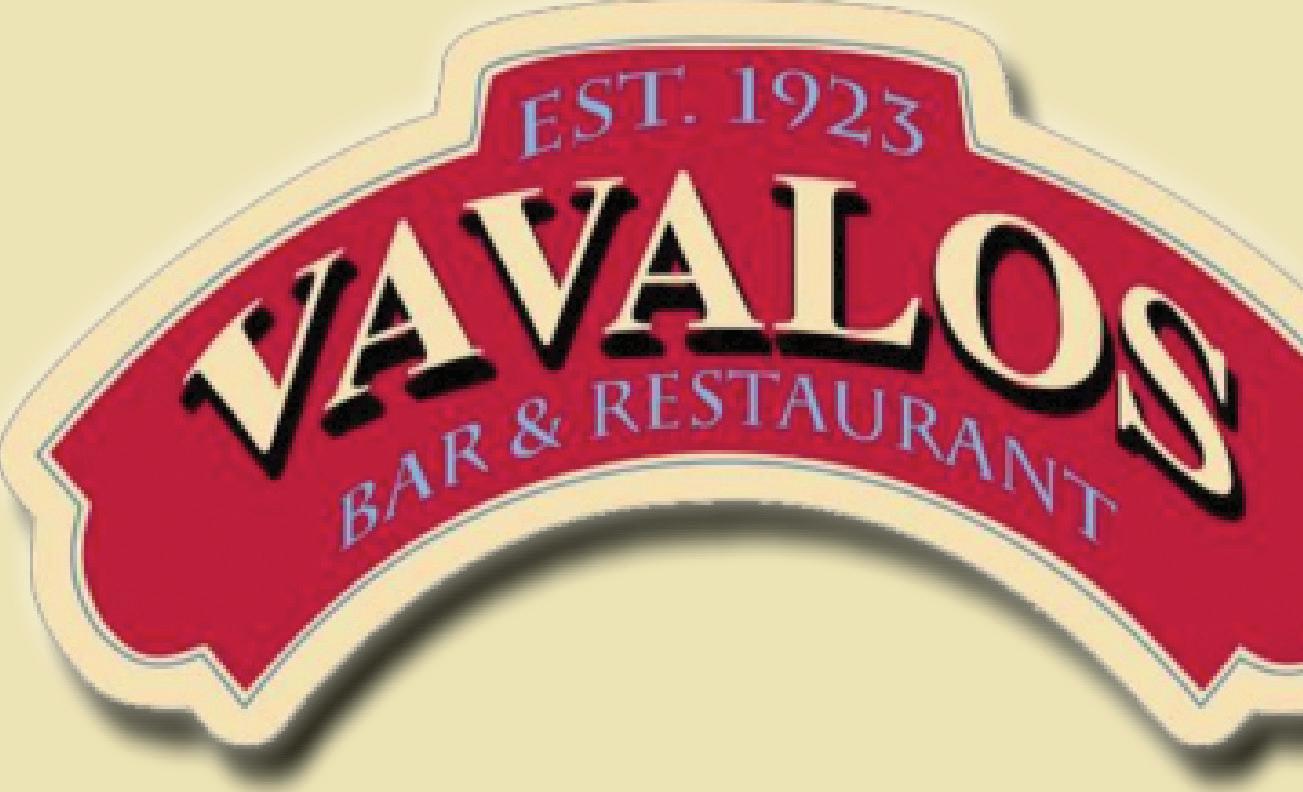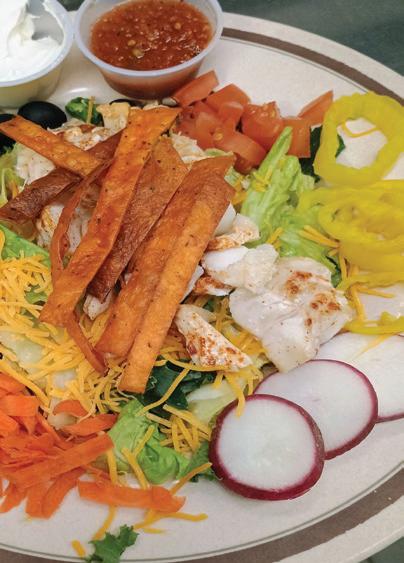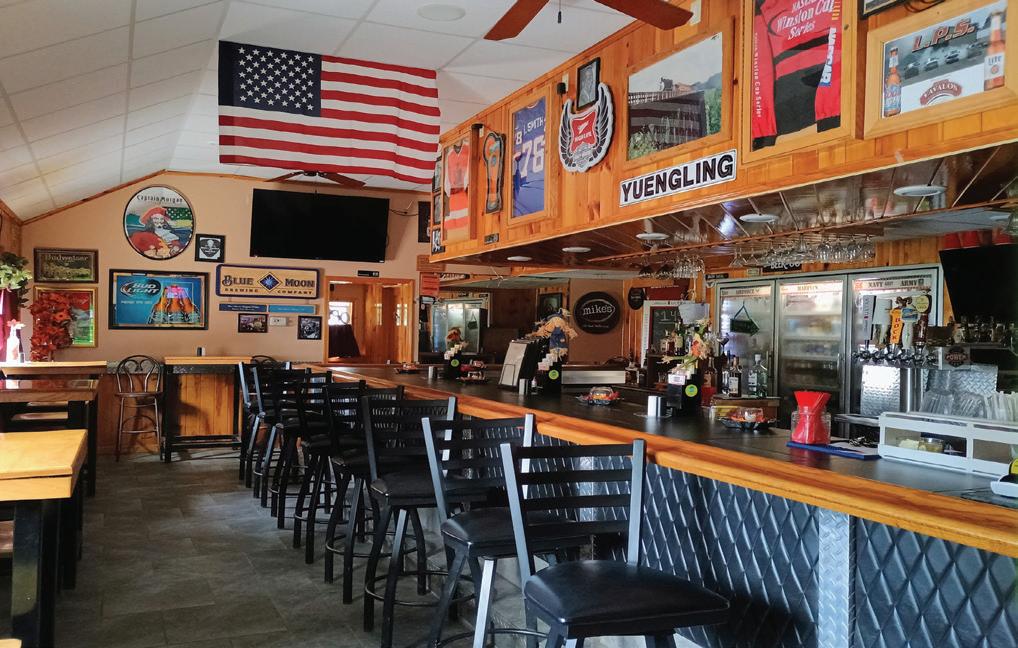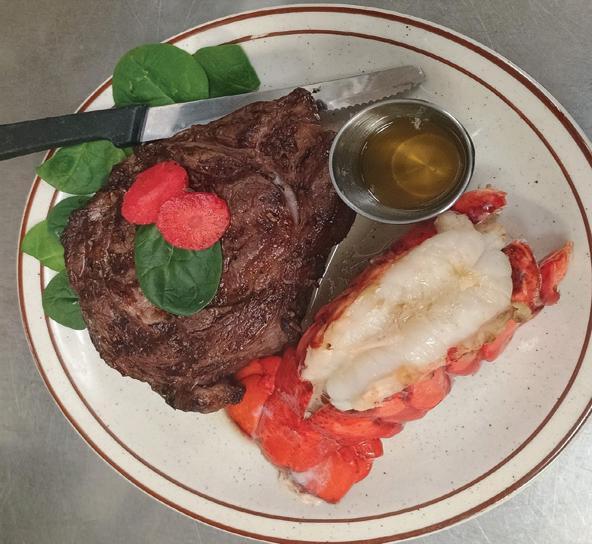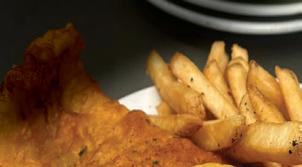








Conventional wisdom regarding tipping when dining out long suggested diners add an additional 15 percent gratuity for the waitstaff when signing for the meal before leaving an establishment. Though that may still be an acceptable barometer, a recent Bankrate poll found that many adults now tip at least 20 percent at sit-down restaurants. The same poll found that 22 percent of consumers now tip at coffee shops as well. Modern tipping etiquette can be confusing, as consumers have undoubtedly noticed the presence of tip cups at establishments where gratuities have historically not been the standard. Confused consumers can take solace knowing they’re not alone, as Bankrate also found that 15 percent of adults are confused about who and how much to tip. Tipping etiquette is not set in stone, but the following are some points consumers can keep in mind the next time they face a situation where a gratuity may (or may not) be called for.
• Standard sit-down restaurant etiquette remains the same.
Various consumer etiquette experts note that tipping trends might have skewed upward, a fact of life that the Bankrate poll indicates. A 15 percent tip on a sit-down meal at a local restaurant remains acceptable, but diners can use that as their
starting off point. Especially attentive servers may warrant a tip at 20 percent or above. And though it can be tempting to tip less than 15 percent if the service is not what diners had hoped for, it’s important that diners consider the lingering effects of staffing issues that many restaurants continue to confront. Such issues arose during the pandemic and many restaurants are still short of qualified waitstaff. So unless a waiter is personally unpleasant or confrontational, diners can tip at 15 percent even if the service was slow.
• Tips are still standard for bartenders as well. The tipping standard remains the same at the bar, where tradition suggests tipping $1 per beer or glass of wine and $2 per cocktail. Cocktails merit a larger tip because they’re harder to make and require more of the bartender’s time. When running a tab, take note of how many drinks you’ve had when paying the bill and tip accordingly. And much like diners might pad the tip for exceptional service from the waiter, patrons can increase their tips for bartenders who were attentive and made an especially good cocktail.
• Tip for takeout at your own discretion. Every
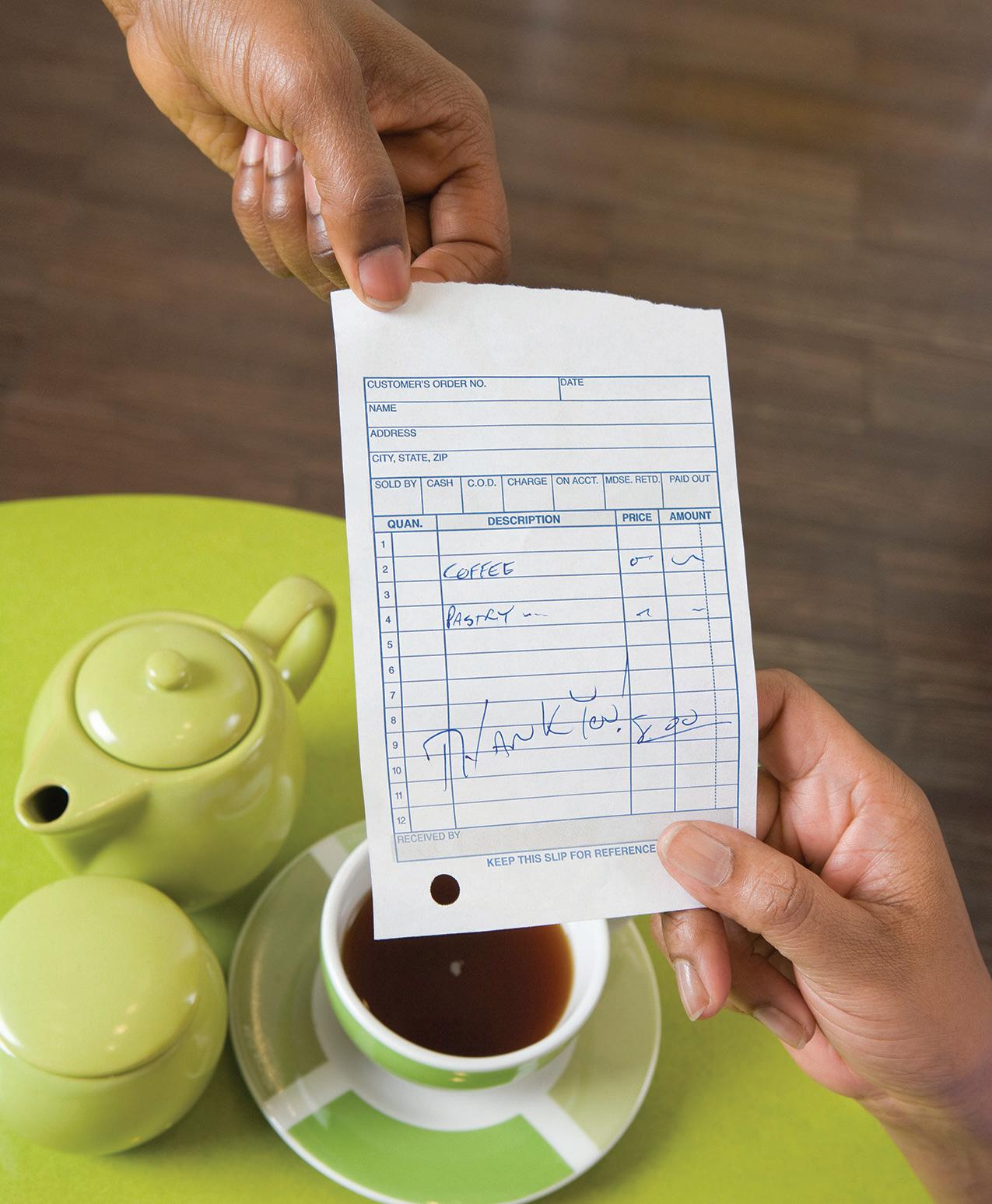
consumer has undoubtedly confronted a tip request when paying for takeout. Various etiquette experts note that tipping at takeout is entirely up to consumers. It’s perfectly acceptable to deny such requests. Diners who want to tip when picking up takeout need not follow the 15 to 20 percent rule that’s customary at sitdown restaurants. An extra couple of dollars is enough for diners who choose to tip when picking up takeout.
• Open-bar events may not require tips. Hosts of open bar events often pay for serving staff gratuities up front, so there’s typically no
need to tip bartenders or servers at such gatherings. Some establishments even forbid staff from accepting gratuities. If a bartender is doing an excellent job handling a large crowd, consumers can offer a tip but should not insist it be accepted if the bartender says gratuities are already included. If a tip cup is out on the bar, the standard bartender tipping etiquette can be applied. When tipping staff at bars and restaurants, diners can keep standard tipping etiquette in mind. Going a little higher than the standards suggest can be called for when service is exceptional.
Even though pizza, wings and beer is a combination that has appeared on game day food tables seemingly since the dawn of organized sports, the nuances of beer open up the possibility for many other food-beverage combinations. Just as wine can complement a variety of different foods when the right combination of flavors is presented, so, too, can one’s favorite brew. Craft brewers have opened the public’s eyes to a much wider array of beer styles than may be available at the local liquor store or supermarket. Below you can find some suggestions for beer and food pairings, courtesy of the Brewers Association.
• Blonde Ale: Match this
ale with lighter food choices, such as chicken, salads, and light, nutty cheeses.
• India Pale Ale: The hoppy forward flavor of IPAs makes these popular beers a good pairing with strong, spicy foods, or bold, sweet desserts.
• Amber/Red Ale: Pair a wide range of foods with amber ales, like chicken, seafood, burgers, and spicy cuisine.
• Porter: The strong flavor of porter will work well with roasted or smoked food, barbecue, sausages, or blackened fish.
• Dark Lager, Dunkel, Schwarzbier: Hearty, spicy foods, barbecue, and roasted meats also
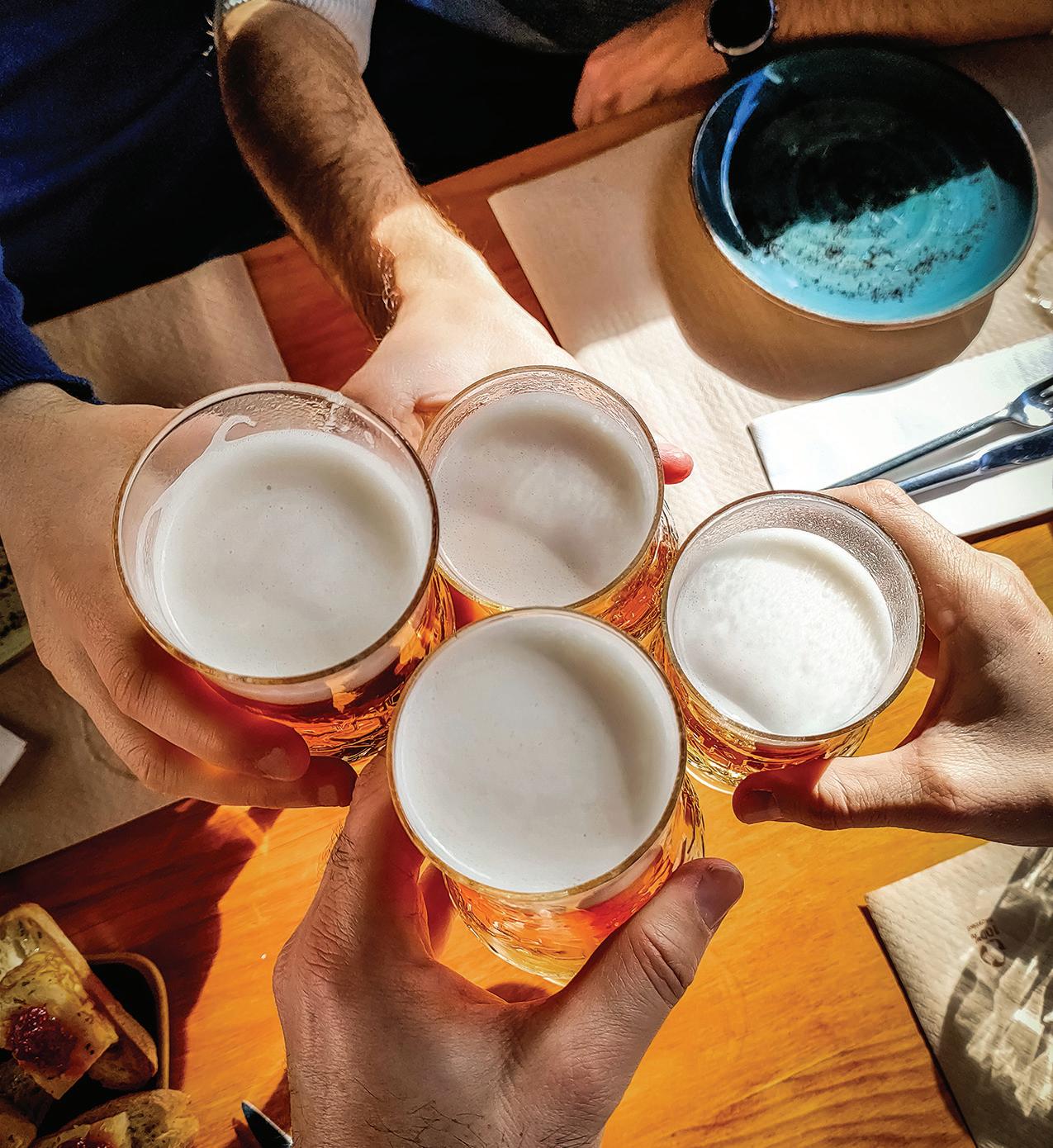
complement these dark beers, as do pizzas and burgers.
• Hefeweizen: Fans of this light German or Austrian beer will learn it pairs well with salads, seafood, sushi, and traditionally weisswurst, a white Bavarian sausage.
• Imperial Stout: This beer can easily overwhelm many foods, but can stand up to foie gras or smoked goose. Long-aged cheeses, like gouda, parmesan or cheddar, also can work with stout, as do rich, chocolate desserts.
• American Wheat Ale: Choose this beer to go with very light foods like salads and sushi. It’s generally too light for dessert, but might work with fresh fruit.
Furthermore, when pairing beer with food, keep in mind that beer with hop bitterness, roasted malt, high carbonation, and higher ABVs balance sweet, rich (fatty) and umami flavors in food. Hop bitterness also can emphasize the spice of foods, such as in chili or certain ethnic cuisines. A sweet or malty beer balances out spiciness or acidity in foods.

Families enjoy meals
out at restaurants in celebration of various milestones, including birthdays, retirements, holidays, and other special occasions. Sometimes families choose to dine out for no specific reason other than to enjoy a change of pace and scenery.
Restaurant dining has increased in recent years and in some areas has reached or even eclipsed pre-pandemic levels.
According to Statistics Canada, in the first quarter of 2023, Canadians spent 39 percent of their food budgets at restaurants. A report from Nielsen indicated the total amount of money spent on food away from home in the United States has risen 94 percent since 2003.
When planning meals out with family members, these guidelines can make the process go smoothly and make for an enjoyable night.
When looking for a restaurant for a family dinner, take convenience into consideration. Try to choose a restaurant that is close to everyone’s home. If that is not possible, solicit recommendations from all who plan to attend.
While some family members will not bat an eye at menu prices, others may have to be more discretionary with their

spending. Putting out feelers to see what everyone feels comfortable spending might be a good idea. Then select a restaurant that fits those needs. Some restaurants will work with larger parties and put together a limited pricefixed menu, which can ensure no one is surprised when the bill arrives.
Nowadays it is essential to be mindful of people’s diets, including foods that they may have
to avoid. Individuals will want to alert the restaurant staff of any special needs well in advance to ensure their needs are accommodated.
If one person in the family is covering the tab, then payment method may not matter. However, if a few different people are contributing to the bill, it may be easiest to have everyone bring cash so that the money can be divided easily. However, money sharing apps like Zelle, Paypal or Venmo
may enable those who do not want to use cash to simply send funds to another person so that this individual will pay the bill.
Book a reservation before peak hours so everyone can relax and take their time. Also, choosing a day of the week other than Friday, Saturday or Sunday also may mean smaller crowds and less wait time to receive food. Dining out with family can be an enjoyable way to spend time together.
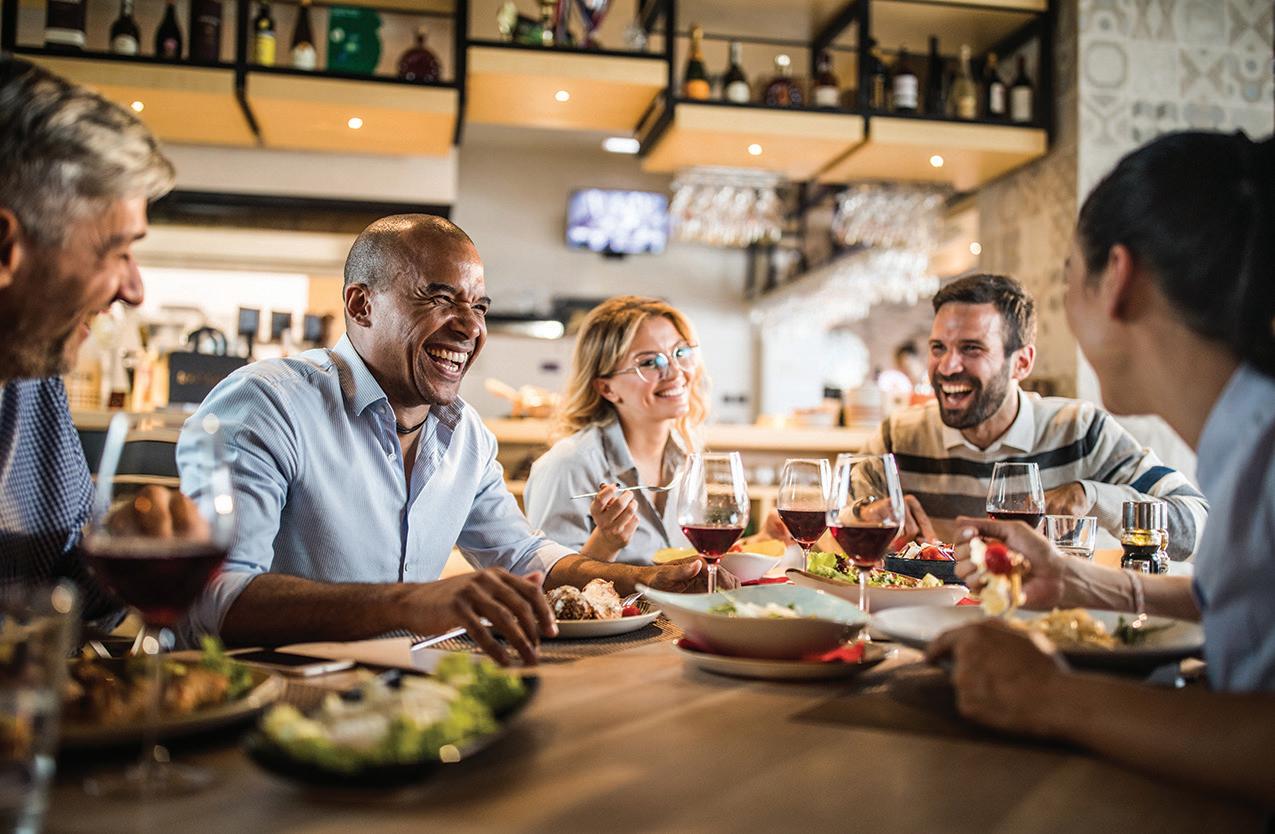
The renowned writer Ernest Hemingway is credited with saying, “My only regret in life is that I didn’t drink more wine.” Perhaps if the author had a better understanding of pairing wine with food, he would have enjoyed his wine a bit more often?
Unless you’re spending time with a master sommelier or a seasoned oenophile, you’re unlikely to be given a hard time if your wine and food pairings are not perfect. Although there is no need to always pair a bottle with food like an expert — and it’s certainly alright to break the rules if you’re particularly passionate about a specific type of wine — a general knowledge of classic food-and-wine parings can help anyone expand their knowledge and please their palate.
And yes, it goes beyond white is for fish and red is for beef. These pairing pointers, courtesy of the experts at Food & Wine, Tasting Table and Wine Folly, can help anyone find the right combination for their dinner table.
As you grow more familiar with wine, you’ll learn why these tried-andtrue suggestions often work.
• Red wines pair best with bold flavored meats (red meat).
• White wines pair best with light-intensity meats (fish and chicken).
• The wine should have the same flavor intensity of the food.
• The wine should be sweeter than the food.
• The wine should be more acidic than the food.
• It is better to match the wine with the sauce than with the meat.
• Think about whether you want contrasting or congruent pairings. Red wines often create congruent pairings while white, sparkling and Rosé will create contrasting pairings.
Congruent versus contrasting Congruent pairings, according to Wine Folly, create balance in the mouth by amplifying shared flavor compounds. For example, earth wines paired with earthy mushrooms. Contrasting pairings create balance through contrasting flavors. Therefore, a salad with acidity and bitterness may be comple-
mented with a wine that is sweeter and not so acidic, or so may be the case with a fatty, salty food like foie gras.
Common pairings to try
• Mushrooms, lentils and even salmon go great with reds like Pinot Noir or Dolcetto. These wines are light-bodied but also full of savory appeal.
• Champagne and oysters work because Champagne has a touch of fruity sweetness. This helps it cut through salty foods like oysters or even chips.
• Cabernet, and Bordeaux are ideal with steaks and lamb dishes. The tannins in cabernet will cut through the protein and fat in these red meats, while the fat balances out the rich tannins.
• You’ll need a wine that pops like Sauvignon Blanc, to go with tangy foods, such as grapefruit or scallops. This white wine also can work with various vinaigrettes or tangy cheeses.
• Chianti is a prized Italian wine made from Sangiovese grapes. High acidity and noticeable tannins will help chianti pair well with high acid foods like those featuring tomato sauces, such as a rich pasta dish.














































































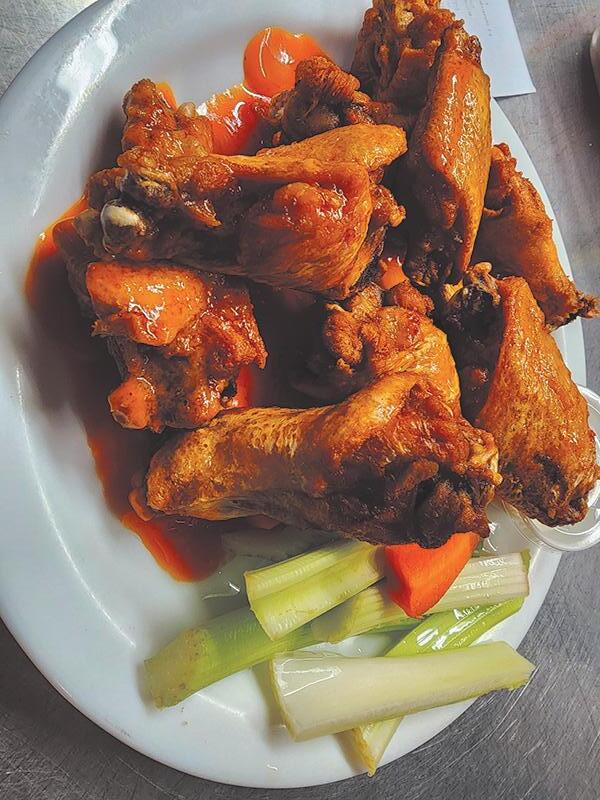
Making smart food choices and watching your portions are hallmarks of many diet plans. While nutritionists often say that losing weight and being healthy involves changing your relationship with food rather than adopting a particular fad diet, even the most carefully designed diets can be derailed when dining out.
According to the Centers for Disease Control and Prevention, nearly one-half of adults tried to lose weight within the last 12 months. In 43 markets surveyed within YouGov Global Profiles, 52 percent of global consumers are “usually trying to lose weight.”
Once people understand what goes into maintaining healthy diets at home, they can extend
those lessons while dining out. The following is a sound approach to making smart food choices when out and about.
• Plan ahead. Look at the menu online and see what the offerings are. This way you can map out what you will be eating without feeling pressured or rushed at the restaurant.
• Don’t arrive hungry. Eat a small snack before you leave home so you’re not arriving at the restaurant with a growling belly. Choose small, protein-based snacks and whole grains, like some hummus and a slice of whole-wheat toast.
• Consider an appetizer. Dieting involves portion control. It can
be easy to eat too much when dining out, as portions seemingly get larger and larger. Instead of choosing an entrée, opt for an appetizer or even something from the kids’ menu, as those portions are likely to be smaller and more in line with the amount of food diners should be eating.
• Fill up on salad or vegetables. Salad and vegetables are nutritionally dense but low in calories for their serving sizes. By eating a salad or making the majority of the meal vegetables, it’s possible to eat fewer calories overall.
• Practice mindful eating. Mindful eating involves paying full attention to the process of eating.

Focus on eating rather than conversation, and try to avoid distractions like watching television while munching, which could compel you to eat too much.
• Make healthy choices. Look for menu items that are smart choices, like lean cuts of meat, grilled or baked foods, broth-based soups, and vinegar-based dressings. Anything that says “fried” or “creamy” likely should be avoided.
• Skip the buffet. When choosing between a sitdown meal and a buffet line, the sit-down entrée may be the smarter choice. The amount of food on the plate will be finite rather than chafing dish after chafing dish of tempting options.
• Avoid alcohol. Medline Plus indicates the average drink can have anywhere from 100 to 165 calories per serving. Certain mixed drinks, like a chocolate martini or piña colada, can exceed 500 calories. By skipping the cocktail or wine, it may be possible to trim several hundred calories off a meal.
Dining out presents unique obstacles to healthy eating plans. But planning ahead makes it possible to dine out without compromising dieting plans.













Adults understand that each restaurant visit presents an opportunity to try something new. North America is a true melting pot, and people from all over the world brought their customs, cultures and food to the continent.
One can pull up a map of his or her immediate area and likely find restaurants offering Italian, Chinese, Greek, Thai, Eastern Mediterranean, and Mexican foods. Expand the radius further, and there is bound to be a bevy of additional offerings as well. These restaurants bode well for adventurous diners who like to try different flavors. But what about children who tend to be more picky with food? Here are some
handy tips for introducing kids to new foods when dining out.
• Begin with a taste. Parents should realize it can take a while before kids are willing to eat new foods. According to Judy Delaware, an occupational therapist, feeding specialist, and co-founder of Feeding Littles, kids often prefer textures and tastes they have had before. It can take anywhere from 10 to 15 exposures to certain foods before a child will give it a shot. When dining out, don’t order an entire meal and expect a child to eat it. Rather, adults can offer a bite or two of their own meals to try.
• Read the menu together. Let the child learn
about the food descriptions and what is in each dish rather than describing the dish as tasty or not. Try to be descriptive when characterizing dishes, using phrases such as “this is creamy” or “this is crunchy.” Curiosity may make kids more inclined to try something new.
• Be a role model. Kids often mimic their parents’ behaviors. By trying new foods themselves rather than eating the same thing over and over again, parents can help set a precedent.
• Get hands on. Let kids explore and “play” with foods at home to familiarize themselves with the textures, looks
and smells of different ingredients. Kids also can go shopping with adults to become acquainted with even more offerings. A study from researchers at the University of Eastern Finland found kindergartners who had hands-on time with fruits and vegetables in their classrooms were more likely to choose these foods from a snack buffet than those who had no such interactions.
• Pair unfamiliar foods with favorites. Slowly introduce children to foods at restaurants. For example, rotate new foods so that carrots are accompanying the chicken tenders this time, and perhaps next time the side dish will be mandarin oranges. Add new toppings to pizza. Eventually kids may be more adventurous.
• Time it right. Most parents know it is hard to get kids to be cooperative if they are tired or especially hungry. Pick smart times to introduce new foods, such as after naps or when going out to breakfast, as kids will be rested and breakfast foods can be less intimidating.
Children can slowly grow accustomed to trying new foods when dining out, helping entire families expand their restaurant options.
Certain types of cuisine tend to inspire a little extra devotion, and seafood is one such food. Seafood is an umbrella term that refers to fish such as salmon and tuna as well as shellfish like shrimp, crab and oysters. That’s a wide range of foods, which underscores the versatility of seafood.
Versatility is one notable attribute of seafood, and diners can keep that in mind as they plan nights out on the town. Another worthy quality of seafood is its nutritional value, which is perhaps more significant than even the most devoted fish and shellfish lovers recognize.
• Fish is low in saturated fat. The American Heart Association notes that fish is not high in saturated fats. In fact, the AHA recommends eating two servings of fish, particularly fatty
fish like salmon, each week. Additional types of fatty fish include bluefin tuna, oysters, mussels, herring, mackerel, and anchovies.
• Certain types of fish and seafood can help lower triglyceride levels. Eicosapentaenoic acid (EPA) and docosahexaenoic acid (DHA) are two types of fatty acids found in fish such as mackerel and salmon that are associated with heart health. The Cleveland Clinic notes that EPA and DHA help to lower triglyceride levels, which is beneficial for a variety of reasons. According to the Mayo Clinic, high triglycerides may contribute to a hardening of the arteries or a thickening of arterial walls, a condition known as arteriosclerosis. Arteriosclerosis is
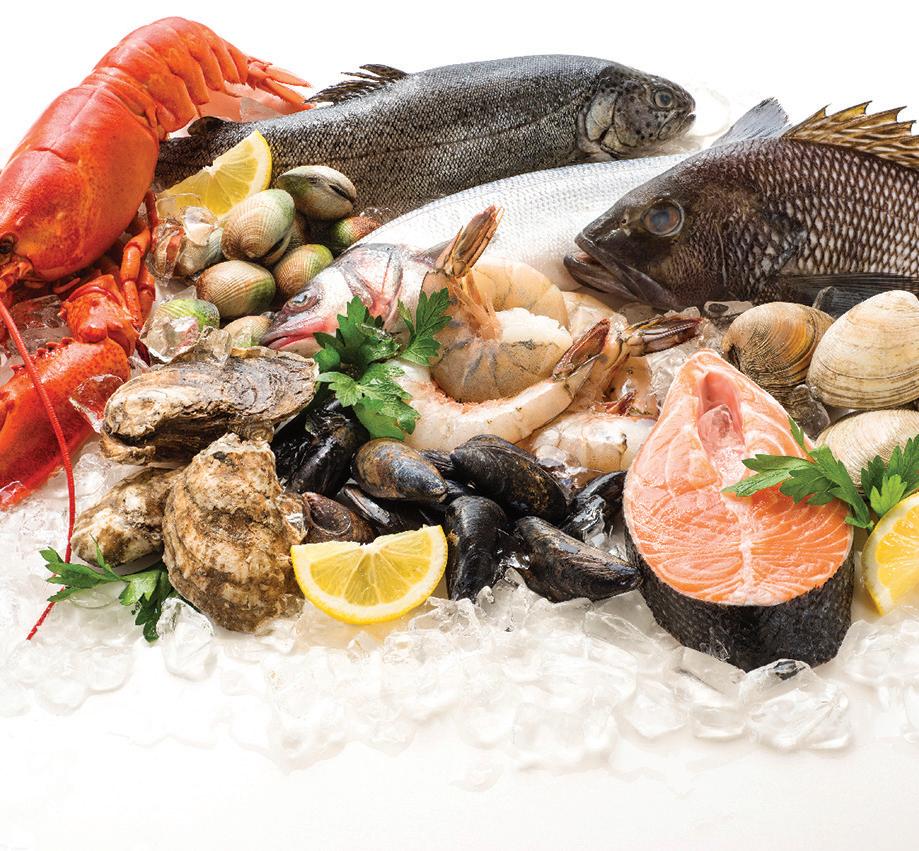
a known risk factor for stroke, heart attack and heart disease.
• Shellfish are high in protein and low in calories. WebMD reports that shellfish are a great source of lean protein. That’s a notable benefit, as lean protein is easily digestible and vital for muscle growth and repair. Lean protein sources also can help people feel fuller for longer periods of time, potentially reducing the likelihood that people will overeat. WebMD notes that a single, three-ounce serving of clams contains 22 grams of protein,
which is more than 40 percent of the daily recommended intake for people adhering to a 2,000 calorie diet. That same three-ounce serving also contains just 126 calories.
Many people mistakenly believe that dining out will compromise their diets. However, individuals who make wise choices when dining out can enjoy delicious foods without the guilt. Various dishes that fall under the umbrella of seafood provide a delicious and healthy option when diners want to hit the town without compromising their overall health.

HOURS: Monday-Thursday: 11 AM - 8 PM Friday-Saturday: 11 AM - 9 PM Sunday: 11 AM - 7 PM











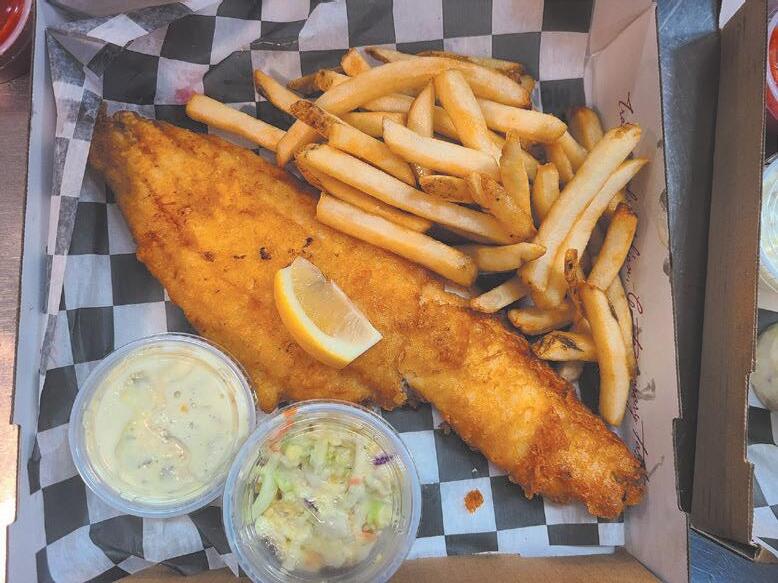

Diners can try an array of unique dishes when dining out. Choices can be made based on different criteria, be it international fare or complicated dishes that are best left to professional chefs. But it’s not just breakfast, lunch or dinner that tempt the tastebuds while dining out. Don’t forget to leave room for dessert, especially at restaurants that feature a number of impressive confections. Though it’s unwise to try them all at once, the following are seven decadent desserts to consider when dining out.
1. Crème brûlée: Despite having only a few simple ingredients, crème brûlée is an elegant and rich dessert. According to NYT Cooking, most crème brûlée recipes require the use of a small propane torch to toast
the top of the dessert to achieve a crackled, sugary top. Vanilla is the custard of choice in this dessert, but some pastry chefs experiment with additional flavors.
2. Tiramisu: Tiramisu is a layered treat comprised of lady fingers cookies soaked in espresso and topped with sweet and creamy mascarpone cheese and cocoa. This classic Italian dessert is very simple, but decadent nonetheless.
3. Crêpes Suzette: According to Food & Wine, this dessert is traditionally made with light and airy crêpes topped with an orange-flavored buttery sauce made from caramelized sugar. As the French Crêpes Suzette typically contains Grand Marnier, triple sec or orange Curaçao,
it is often flambéed tableside.
4. Sachertorte: This Austrian dessert classically layers chocolate cake with apricot preserves and is one of the most famous Viennese culinary specialties. The rich dessert is made even more decadent thanks to the dark chocolate gânache glaze.
5. Napoleon pastry: Napoleon pastry also is known as mille-feuille, which is a classic French dessert that has been enjoyed for hundreds of years. It is made of many layers of puff pastry layered with pastry cream.
6. New York cheesecake: Arnold Reuben, who owned Reuben’s Restaurant and Delicatessen, is credited with creating the New
York cheesecake in the 1920s. Various institutions have different interpretations of New York cheesecake. It may be made only with cream cheese or with the addition of sour cream. Others say that the cheesecake should stand alone with no crust, while other recipes feature a graham cracker crust. Most people agree the New York cheesecake should not have any toppings.
7. Cannoli: Cannoli is a Sicilian dessert made from tube-shaped shells of fried dough filled with a creamy filling made from a ricotta cheese base dotted with chocolate chips or candied fruit rinds. Dining out presents perfect opportunities to indulge in any number of decadent desserts.
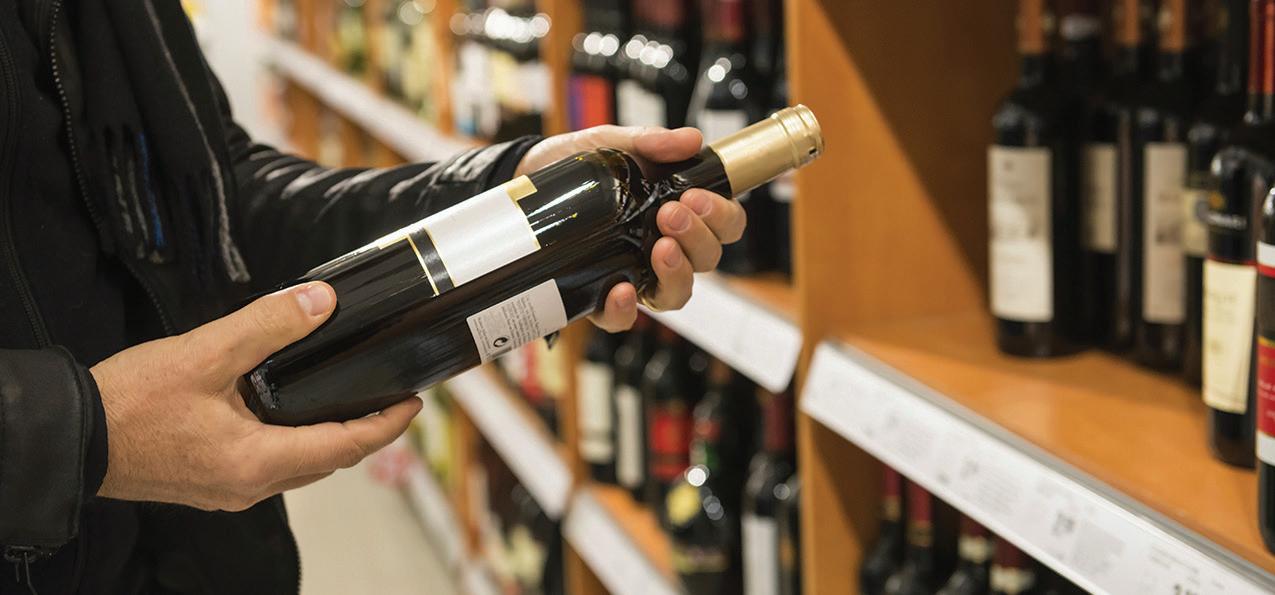
According to Wine Folly, when pairing wine with dessert or other foods, the secret is to think of wine as an ingredient that will add a new flavor profile. Generally speaking, when it comes to choosing the best wines for desserts, a sweet wine is preferable as the sweetness in the wine will match the sugar in the dessert, suggests the wine resource Vin Yang. Here are some additional pairing pointers.
• A darker dessert usually requires a darker wine, as the wine should have a similar intensity to the dessert.
• The wine should be sweeter than the food in most cases.
• The flavors in the wine should match the flavors in the food.
• Chocolate and caramel are best paired with
a sweet or fruity red wine, as dry wines may taste too bitter against chocolate due to the tannins found in both the wine and chocolate. Port, Sherry, Marsala, and Zinfandel are good options.
• Mild, buttery or sweet vanilla desserts work best with white wines, including sparkling wines. Muscat, off-dry Rieslings, and Prosecco are some ideas.
• Keep in mind that very sweet desserts or those with fruits, like cobblers or shortcakes, may benefit from a burst of acidity. A drier Riesling may work or a Vouvray Brut.
Those who may be unsure of how to pair their desserts with wine can always speak with a wine retailer or a trusted restaurant sommelier for suggestions on wines.































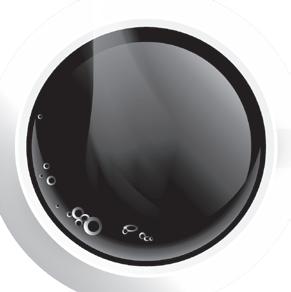


























Visiting a restaurant is a popular way to enjoy a night out with family or friends. Dining out affords individuals a break from cooking at home and offers an opportunity to try new cuisines and enjoy a complicated dish that novices may find difficult to prepare.
Special occasions also may be celebrated by dining out, bringing together a large party of customers at one time. When dining out as a crowd, some additional planning may be necessary to ensure the experience goes well.
The first thing is to consider speaking with the restaurant about how they handle large dining parties. While some
restaurants may simply request a reservation (and updates on whether the party count changes), others may treat a crowd of eight or more differently and refer such groups to a party planner or catering manager. Follow the rules of the restaurant to make things easy for their kitchen staff and the waitstaff.
When bringing a large dining party, sometimes it can be easier to work with the restaurant and have a party menu set up. This menu will feature a few different options rather than giving the group free rein over the standard menu. A party menu means you can keep things to a set price and advise those dining out about
what they can expect to pay if the bill will be split.
Who will pay for the meal also merits consideration. It’s essential to decide in advance if the bill will be paid by one individual or if it will be split equally among those attending the dinner. If it is the latter, it may be easiest if everyone brings cash to make chipping in for a single check more seamless than handing over 10 different credit cards or requesting multiple checks. Also, paying cash means diners will not be subjected to the extra fee that many restaurants are now placing on credit card payments to help offset their costs for accepting such forms of payment.
Plan for the group to arrive at the same time. Many restaurants will not seat a party until all diners are present. Also, once the group is finished dining, it may be tempting to linger for a while and engage in conversation. This can affect the turnover rate of the table and some establishments may not be fond of it. Rather, think about moving over to the bar area (if there is one) or take the group to another bar nearby to continue catching up.
Dining out as a large party involves planning ahead and being cognizant of the protocols in place at the establishment you will be visiting.
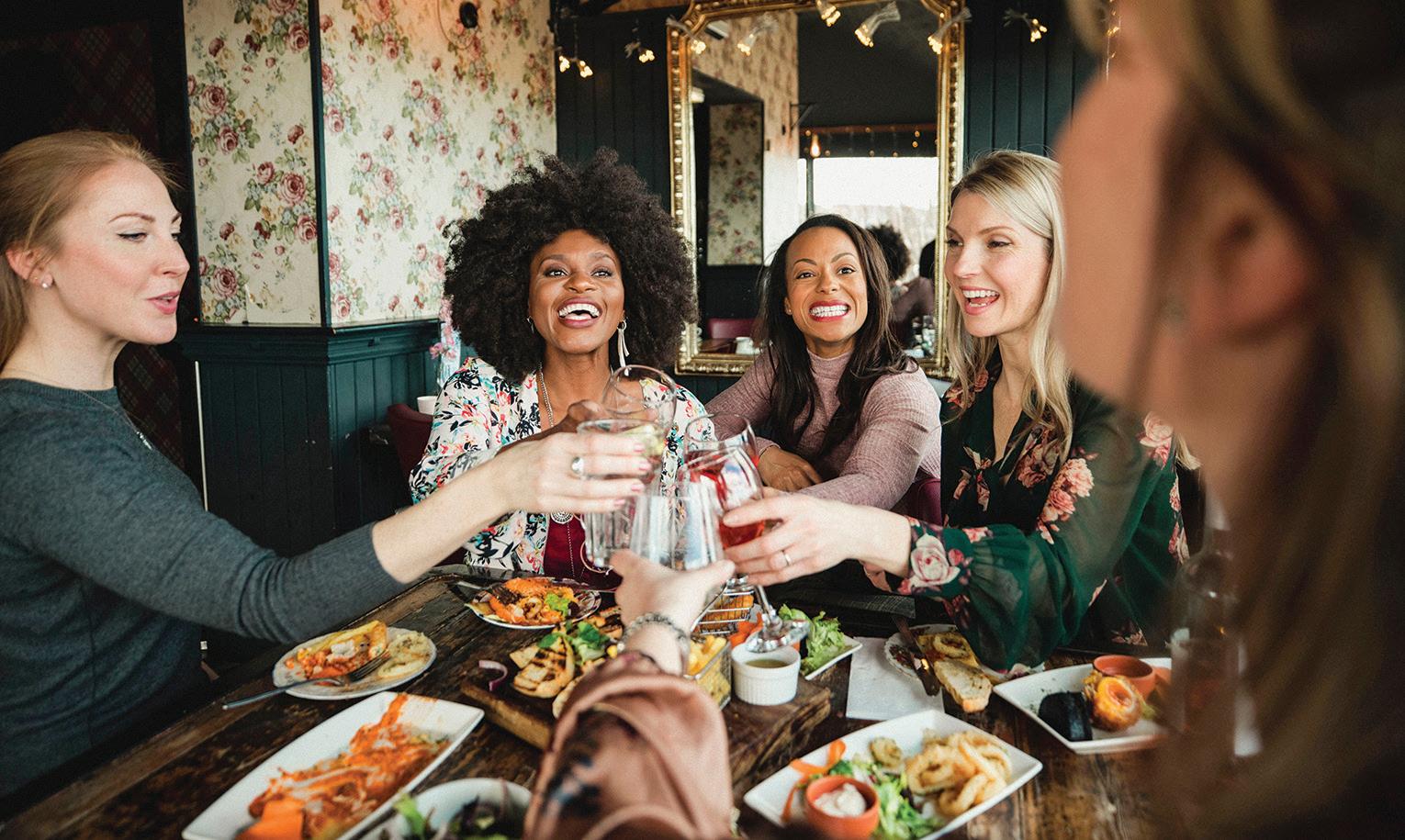
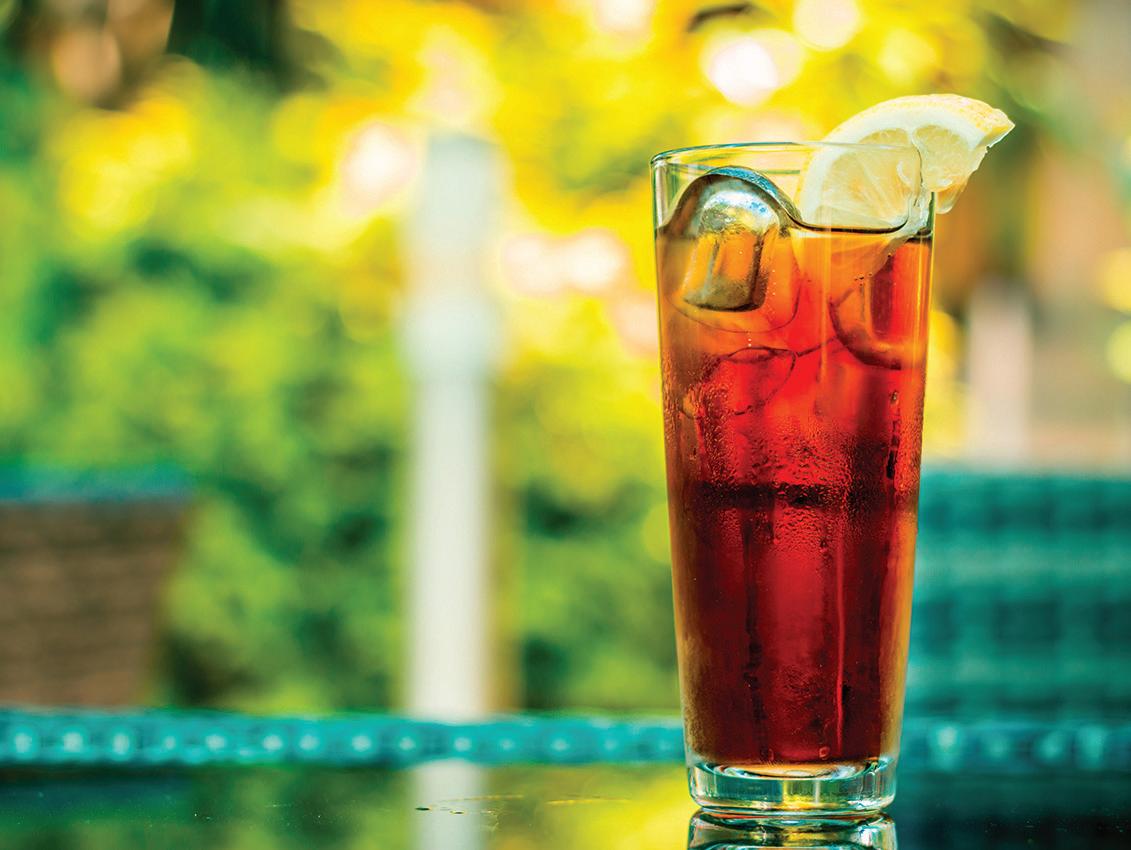
Dining out or attending social functions often affords access to various types of foods and beverages. Cocktails and other alcoholic drinks will likely be on the menu as well, tempting people to indulge. Although one alcoholic drink while out at a restaurant will not sabotage a healthy eating plan, when spending a prolonged time in social situations, individuals may be compelled to have multiple drinks, which can be unhealthy and potentially unsafe. According to the Center for Science in the Public Interest, gin, rum, tequila, vodka, or whiskey each feature between 100 and 120 calories per 1.5-ounce shot. The average beer comes in at 150 calories per serving. It’s
easy to see how calories can quickly pile up. Many people would rather save their calories for food than drink them away. Thankfully, individuals can choose from an array of low-calorie, non-alcoholic beverages when hitting the town.
Kombucha is a fermented drink made from tea, sugar, bacteria, and yeast. Since it is fizzy, kombucha can replace beer when dining out. There are various flavors of kombucha, and many replicate the flavor profile of a tangy or refreshing cocktail.
You’ll have to check the nutritional information
for creating a feeling of lightness and tranquility. It may be consumed as an alternative to alcohol to relieve anxiety. While kanna is usually sold in powder form, it can be brewed into a tea or used to make other beverages.
regarding caloric content since options vary, but if skipping alcohol is the ultimate goal, non-alcoholic beers and ciders are good options. They offer the flavor and effervescence of their traditional counterparts without the alcohol.
Club soda mixed with bitters, cranberry juice, lemon/lime, or other flavor combinations can create flavorful alcohol alternatives. Plus they are refreshing and will not cause dehydration, which can occur when consuming alcohol.
Kanna is a plant used in South Africa for centuries, according to Trip, a CBD retailer. Kanna is known
Ginger beer is spicy and potent, making it much stronger than its cousin, ginger ale. It’s made by fermenting ginger, sugar, water, and lemon juice, says Medical News Today. The result is bold ginger flavor with natural carbonation. Like other soft drinks, the calorie count in ginger beer varies depending on the brand. There are sugar-free alternatives that can help reduce the calorie load.
Matcha or other teas
Matcha is a type of green tea that is exposed to more sunlight to produce higher chlorophyll and amino acid content. Matcha, like other teas, is high in antioxidants, which is a boon for the body. Matcha is widely available at coffee shops and other establishments. Chilled versions of matcha can be substituted for alcoholic beverages when people want to relax and unwind. Additional tea alternatives include regular iced black or green teas. A night out is a great time to try new drinks. Those who want to avoid high-calorie alcoholic beverages have many alternatives to choose from.









































814-362-2222
Hours: Monday-Wednesday: 3 PM - 9 PM Thursday: 11 PM - 9 PM Friday-Saturday: 11 AM - 11 PM Sunday: 11 AM - 9 PM



















Professionals spend years saving for retirement. Many enroll in an employer-sponsored retirement plan the moment they begin their careers in their early twenties, and continue to build their nest egg until the day they officially call it quits. The effort people put into retirement planning makes the moment individuals call it a career worthy of an extraordinary celebration. The following retirement planning party tips can ensure a celebration that suits an occasion as significant as the day professionals call it a career.
• Pick a unique venue. Whether the party will be a sizable affair with a guest list that includes long-time colleagues and friends or a smaller gathering with a retiree’s close knit inner circle, a unique venue underscores how significant a moment and achievement retirement is. For larger
affairs, shop around for venues in much the same way you might when celebrating other milestones, such as a child’s graduation from college or a wedding. If the guest list includes just a handful of friends and family members, consider planning a trip to a resort locale or renting an impressive home through a site like Airbnb or Vrbo.
• Take a stroll down Memory Lane. In the months leading up to the celebration, work with the retiree to identify key moments and people in his or her career. A photo montage of those notable moments and individuals can be a great way to commemorate a lengthy career and simultaneously thank and honor the people who helped along the way. Play the montage for guests at a key moment during the party.
• Ask colleagues to share well wishes. Brief messages from colleagues, whether they’re delivered via handwritten letters or videos each individual films, can be a great way to show the guest of honor how much he or she meant to others throughout their careers. Messages can be incorporated into a montage video or shared privately with the guest of honor.
• Kick the curfew to the curb. It might have been a while since a newly minted retiree had a late night, but a retirement party can stretch into the wee hours. After all, the guest of honor won’t need to wake up for work the next day (or any other day), so let invitees know that the party will keep going well into the night. If booking a venue for the party, plan an after party at your home for a handful of guests
who are particularly close with the guest of honor.
• Keep the focus on fun. While reaching retirement is a celebratory moment that merits a good party, many retirees also feel a degree of sorrow because they’re leaving behind rewarding careers they worked so hard to build. Such sentiments may not be entirely avoidable, but party planners can emphasize fun and a festive atmosphere to ensure the night is celebratory and not sorrowful. Book a band and submit a play list of the retiree’s favorite songs, and encourage guests to dance the night away. The day professionals reach retirement merits a celebration that’s worthy of the years of hard work and dedication individuals put in over the course of their careers.
There are plenty of reasons to love pizza, and pizza lovers can dig into new ways to get their fill of this famous comfort food. Check out these facts that are bound to get you even more fired up about pizza, courtesy of Papa Woody’s Pizza, DeNiro’s Pizza, Big Mario’s New York Style Pizza, and DidYouKnow.com.
• More than 10 percent of food service sales in the United States involve pizza. Plenty of people are ordering pizza to their homes or dining at restaurants that serve this beloved dish.
• Pepperoni is the most popular pizza topping (if you’re not counting cheese).
• Pizza consumption tends to be highest during sporting events. Pizza retailers sell millions of pizzas during the Super Bowl every year, for example.
• When pizza originated in Naples, Italy, it was intended to be an option for low-income families, as it was a cheap meal to make at home.
• Researchers at The Artificial Language Laboratory used a computer to order a pizza in 1974 to test the computer’s
speaking ability. The order was a pepperoni, mushroom, ham, and sausage pizza from local pizzeria Mr. Mike’s.
• Around 80 percent of Italian cheese production in the United States revolves around making mozzarella to accommodate the pizza industry.
• Americans love their pizza. Of the more than five billion pizzas sold worldwide each year, approximately 60 percent of them are sold in the U.S.
• The outer edge of the pizza is known as the “cornicione.” Despite the interesting name, chances are someone in your household leaves that crusty goodness behind on the plate after enjoying a slice or two.
• When American World War II soldiers returned home after eating pizza in Italy, they brought their love for this food with them and helped bring pizza to the masses.
• Each year, the International Pizza Expo takes place so that those in the pizza industry can mingle and share information about this delicious food.


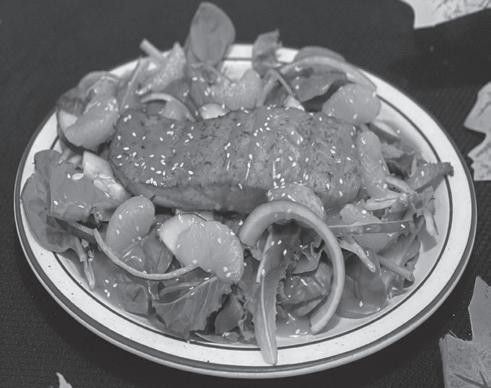
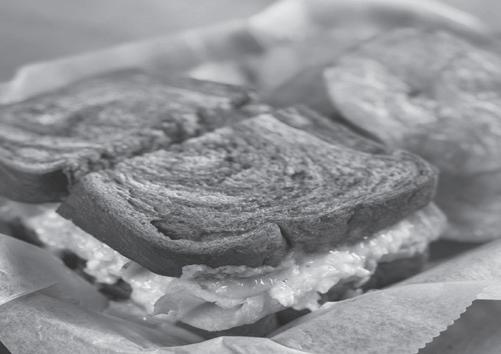
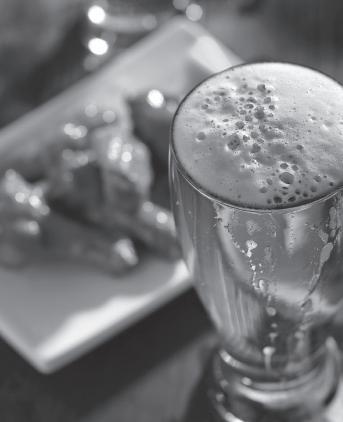

from back in the day!
Two poached eggs on toast
- Water
- Butter
- Garlic
- Baked beans
- Put a hamburger on the grill
- Milk
- Seltzer or soda water
- Coffee with cream and sugar.
- A hot dog with sauerkraut
- Beef stew
- A hamburger with lettuce, tomato and onion
t - Eggs
-
Eggs on toast
- Buttered toast
- A cup of coffee
- A hot dog
- Onion
- A cup of black coffee
Spareribs (probably a pun on Eve being made from Adam’s rib)
- Tapioca pudding










